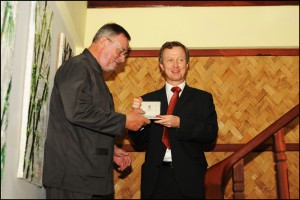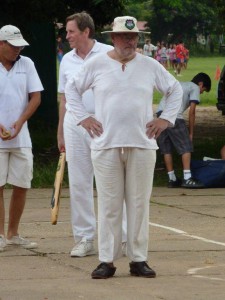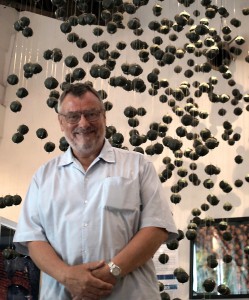14th November 2013 Vientiane, Laos
Laos through my eyes – Mike Boddington
This article is part of a series of guest blogs contributed by Brits who have lived and worked in Laos, or who have other interesting links to Laos.
My love affair with South East Asia began in 1971, when I was fortunate enough to be appointed to a short-term consultancy with the United Nations Economic Commission for Asia and the Far East (ECAFE – now UNESCAP). My first trip outside Europe and it was love at first sight. My mind was blown. The richness of the experience was indescribable. Strangely, one of the most enduring memories that I took away from that time was the fruit. What fantastic diversity of exotic species: just loved them – and I still do.
I was determined to come back. But my next opportunity was in 1978 and then it was Hong Kong where some colleagues and I established a landscape planning practice – Urbis which is still thriving to this day, though without me for many years. It was a long time before I got back to SE Asia. Twenty years after that first experience, in fact.
In 1991, I was asked by the Cambodia Trust to help find ways to prevent Pol Pot from returning, by trying to fast-track income growth for poor people: yes, if only!
At that time, there was only one international flight per day into Phnom Penh (unless you were able to hitch a lift with ICRC) and that was from Bangkok, leaving at 0500 daily. Even with a reserved ticket, there was no guarantee that you would be able to fly, unless you were at the airport at 0300: it felt quite like pioneering.
That led to meeting the British Ambassador, David Burns (the first British Ambassador for 15 years – sound familiar?) and his wife Inge, who were hugely helpful and supportive.

As this work was progressing, Hun Sen asked the Chair of the Trust if some assistance could be given to rehabilitating landmine amputees, who were estimated to number around 85,000 at that time – a figure that would later be reduced to 35,000, still a terrible statistic. In those days, I had never met the word ‘prosthetic’ before, let alone ‘orthotic’ and looked them up in the dictionary. The first, I discovered, was sandwiched between ‘prostate’ and ‘prostitute’, and the second was just not recognised by the scholars at Oxford!
And that became my introduction to working with landmine accident survivors, and with people with disabilities more broadly. In November/December 2011, the 11th Meeting of the States Parties to the Landmine Ban Convention (The Ottawa Treaty) was held in Phnom Penh: it was just down the road so I decided to go and meet up with old friends. The event marked the 20th anniversary of the founding of the International Campaign to Ban Landmines, which was born in Cambodia; a double anniversary that we shared.
Through the late 1990s, I continued to work with the Trust as we set up three rehabilitation centres and the Cambodia School of Prosthetics and Orthotics (CSPO).
In 1993, with Stan Windass, my colleague from the Cambodia Trust, we began to explore the need for such services elsewhere and discovered the worldwide scourge of landmines and the terrible tragedy of their victims. The Cambodia Trust seemed too closely associated with an individual country (though it has now extended into other countries) and unsuited, through its name, to carriage elsewhere, so, early in 1994, the first steps were taken to establish Power International.
We consulted ICRC who enthusiastically supported the idea and suggested that we should focus on Laos (where ICRC had never been able to work) and Mozambique (where they now needed to hand over their programme).
Thus it was, in August 1994, in company with Terry Nother, Chief Prosthetist from the Cambodia Trust, and Frank Cook MP (now deceased) with his Lao ladyfriend, Somsangouane Baldinger, who was with us to open doors at the very top of government, we set off from Phnom Penh for Vientiane to see what needed doing, carrying with us the best wishes and words of warning of UK Ambassador Paul Reddicliffe, who had replaced David Burns: he had once served in Laos and retained warm memories of his time but was also aware of the difficulties that we might face in this country that had been shuttered for most of the past 20 years.
Getting into the Lao People’s Democratic Republic at that time was difficult. Visas must be obtained in advance, and they were only available from Lao embassies overseas, which then numbered 14: the nearest to UK was Paris. Needless to say, tourism was almost non-existent. The first edition of the Lonely Planet Guide to Laos, just published, warned that visas would take two months to arrange from anywhere except Thailand.
Perhaps because of our distinguished company, or the intervention of Paul Reddicliffe, we were able to secure ours in two days.
We flew into Vientiane on one of the old Chinese copies of a Russian twin-engine plane that accommodated about 50 people in cramped circumstances: there was a Boeing 737-200 on this route, leased from Iceland, but that day it was not operational because the pilot had been knocked off his motorcycle in Vientiane and killed. Nothing changes.
We were met at the airport by the vehicle of the Vansana Hotel – the single Lao Vansana hotel in those days, at Phonthan. This was to become my base every time I visited Laos and the place where I stayed for 21 months when I moved to the country: my home-from-home, and Sengkham Phinith, the owner and man of very many accomplishments, remains one of my dearest Lao friends.
We determined that there was a need for a prosthetic and orthotic project in Laos, and that led me to quarterly, week-long visits over the next seven years.
In October 1995, I arrived in-country with our start-up team, working out of the National Rehabilitation Centre[1] in Khou Vieng. I became frustrated at the time that it was taking to get a Memorandum of Understanding signed: today, others might wonder at the remarkable speed – five weeks for an MoU that was to stretch a full ten years to the end of November 2005!
It was my ambition to create a partnership operation with all of the organisations working in rehabilitation, and that took until November 1997, when COPE[2] was formed with the Ministry of Health, Power, CSPO and World Vision as the founding partners. Later, the Japanese Association for Aid and Relief (AAR) came in and was responsible for the wheelchair workshop, and the UK Leprosy Mission International (TLMI) became a vital partner through difficult times.
The UK Department for International Development (DfID) was a significant donor in the early years, as we established a programme that developed five rehabilitation centres to cover the country, and started to train Lao nationals in rehabilitation skills at the CSPO. Once the Diana Princess of Wales Memorial Fund (DPWMF) started operating overseas, it too became an important contributor.

In 2000, we started looking for a local disabled people’s organisation (DPO) to join the board of COPE. There was no such thing, although a vestigial Lao Disabled People’s Association (LDPA) existed. So we decided to try and increase its capacity and build it as a truly nationwide DPO able to look after the needs of all people with disabilities.
That was one of the most challenging things that I have ever done in my life and much of it went according to plan, entirely funded by DPWMF and DfID. Despite reversals since that time, the fundamental structure that was put in place then is still there: it has proved robust.
I retired as CEO of Power in July 2001, and started to look around for somewhere warmer to live out my days. My initial forays were not successful, but a request from Power to come out to Laos in an emergency capacity at the beginning of 2002 opened my eyes to the prospect of this wonderful country as the paradise-on-earth I was seeking: I never left.
In those early Lao days, I was the Power representative in Lao PDR, the CEO of COPE, the Advisor to LDPA and the country representative for British Executive Services Overseas (BESO), which seemed like a reasonable quota for a retirement package! At the same time, I built my house in Ban Xokkham and then I married Dr Xoukiet Panyanouvong (UNDP’s anti-human trafficking tsarina).
That was a truly important step and it brought with it the Panyanouvong family, who have been such an incredible support to me through thick and thin.
Bit-by-bit, I stepped down and away from my jobs, seeking to be replaced by local people trained up to the job, and to finally retire. Then, bit-by-bit I got sucked back in again, first as the Executive Consultant to the Lao CEO of COPE, and then as the Technical Advisor on Victim Assistance to the National Regulatory Authority for the Lao UXO Sector (NRA).
One of the problems for COPE was finding a way to build a more sustainable future, independent of international donors (who rarely like to fund any project for more than three years). In 2007, the International Finance Corporation was promoting tourism programmes aimed at getting people to ‘stay another day’: the focus was to get them involved in local good works and I was approached and asked if COPE would be prepared to cooperate.
It led to groups of tourist walking through the rehabilitation centre in Vientiane, gawping at our clients, and this was obviously not a good situation. The idea grew to develop a Visitor Centre and that went ahead, with a lot of help from Jo Pereira and friends, and opened in 2008, much as it is today, though there have been some changes.
An early visitor was Andrew Mitchell, then on the UK parliamentary opposition benches, with Lord Ashcroft and shepherded by the UK ambassador from Bangkok, Quinton Quayle. Michael Ashcroft made a donation to COPE based, much to his amusement, on the difference in age between Xoukiet and me – $2 per day, and it came to $22,000!

The Visitor Centre has become a huge asset to COPE, bringing in up to 20% of the total operating costs every year.
My work with COPE came to an end in December 2009 and that with the NRA in July 2010. I feel pleased that the NRA was left with a tremendous body of information about UXO casualties, survivors and the services available or needed to serve them and other people with disabilities, as well as a system to track casualties through their rehabilitation experience.
At last, I was genuinely facing a splendid retirement – until I was asked to become the Specialist on Disability and Rehabilitation to the National Science Council in the Prime Minister’s Office. Then in mid-2011, Power invited me to become its chairman, which also put me back on the Board of COPE. As they say, swings and roundabouts!
That Power role has turned into a full-time job with regular journeys back to UK and responsibility for projects in Laos, Mozambique and Zambia, which require visiting on my old quarterly routine!
Any regrets?
Not speaking Lao, because I have been continually too busy to learn and those around me almost universally speak English. Being 6,000 miles from my four children and four grandchildren has been a sadness, though I have been blessed with many visits from them. One of the great benefits that has emerged over the years, as Laos’ reputation as a tourist destination has grown, has been the number of friends who set off to SE Asia and spend three days, a week, ten days, a fortnight with us – truly quality time.
So great has become the trail of visitors that we have constructed a guest house in the garden to accommodate the flow!
It has to be said that working in Laos has been a hard row to hoe; things happen very slowly – step-by-step as they are fond of saying here – and officialdom harbours great suspicion of foreigners and their motives. Well, Laos has not been treated especially well by foreign nations, so one cannot say one blames them. I just wish they could trust their own people rather more!
But as the years of my fifth decade (to be pronounced deck-aid and not decayed, please) of love for Southeast Asia pass increasingly into history, the passion grows only stronger. This is home. Thank you Laos.
[1]Now the Centre for Medical Rehabilitation (CMR)
[2]Cooperative Orthotic and Prosthetic Enterprise
1 comment on “Laos through my eyes – Mike Boddington”
Comments are closed.